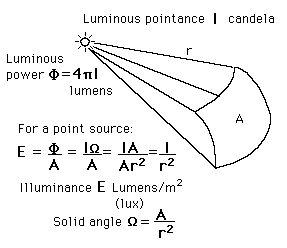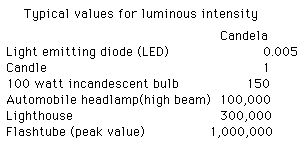Power Per Unit Solid Angle
The power (flux) per unit solid angle (sometimes called pointance) is the nearest precise terminology to the common term intensity. It expresses the directionality of the radiated energy and is appropriate for the description of point sources. In the case of radiant power, it is expressed in watts per steradian. For visible light it is expressed in lumens per steradian = candela.

If the intensity ( I = dF/dw ) of a source is the same in all directions, the source is called isotropic. Otherwise, for a flat radiating surface, known as a lambertian, the intensity falls off as the cosine of the observation angle with respect to the surface normal.
| Radiometry and photometry | Unit illustration |
| Inverse square law for light |
Vision concepts
Light measurement concepts
| HyperPhysics***** Light and Vision | R Nave |
